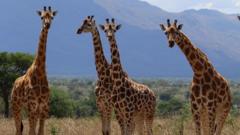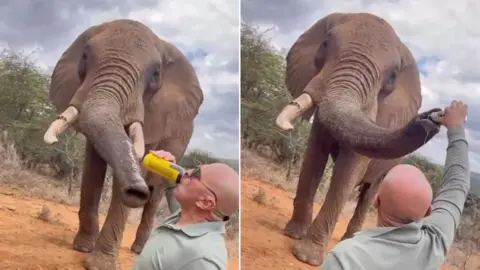In a notable advancement in zoological research, scientists from the International Union for Conservation of Nature (IUCN) have disclosed that giraffes, long regarded as a single species, are officially recognized as four distinct species. This classification is hailed as a significant step toward understanding and preserving these iconic animals.
The categorization emerged from a thorough analysis comparing skull sizes and head shapes, revealing enough genetic diversity among giraffes to categorize them as separate species. Key geographical features throughout Africa, including rivers and valleys, were identified as natural barriers that led to the separate evolution of these four groups.
Among the newly recognized species is the Southern giraffe, which inhabits nations like South Africa, Namibia, and Zambia. The Kunene and Zambezi Rivers, along with the dense rainforests of the Congo Basin, played pivotal roles in isolating these giraffes from others.
The Reticulated giraffe, the second newly classified species, roams the savannas and grasslands of Kenya, Somalia, and Ethiopia. This species likely evolved in isolation due to the area's geographical barriers, including the Tana river and mountainous terrains.
In addition, the Northern giraffe, located in regions spanning western Ethiopia through Uganda, has its migration patterns and the presence of the Nile River and Lake Victoria separating it from other giraffes.
Last but not least, the Masai giraffe, known for its striking blotched coat pattern, inhabits the landscapes of Kenya, Tanzania, and Uganda. Its range is positioned distinctly apart from the Northern giraffe due to major waterways.
This newfound understanding is crucial for conservation efforts as the IUCN emphasizes that comprehending genetic differences between these species will enable more effective protection strategies. Previously classified as vulnerable, the giraffe's new status will prompt a reassessment of the conservation needs of each species.
As research advances, the hope is to enhance the protective measures for these majestic mammals, ensuring their survival for generations to come.
The categorization emerged from a thorough analysis comparing skull sizes and head shapes, revealing enough genetic diversity among giraffes to categorize them as separate species. Key geographical features throughout Africa, including rivers and valleys, were identified as natural barriers that led to the separate evolution of these four groups.
Among the newly recognized species is the Southern giraffe, which inhabits nations like South Africa, Namibia, and Zambia. The Kunene and Zambezi Rivers, along with the dense rainforests of the Congo Basin, played pivotal roles in isolating these giraffes from others.
The Reticulated giraffe, the second newly classified species, roams the savannas and grasslands of Kenya, Somalia, and Ethiopia. This species likely evolved in isolation due to the area's geographical barriers, including the Tana river and mountainous terrains.
In addition, the Northern giraffe, located in regions spanning western Ethiopia through Uganda, has its migration patterns and the presence of the Nile River and Lake Victoria separating it from other giraffes.
Last but not least, the Masai giraffe, known for its striking blotched coat pattern, inhabits the landscapes of Kenya, Tanzania, and Uganda. Its range is positioned distinctly apart from the Northern giraffe due to major waterways.
This newfound understanding is crucial for conservation efforts as the IUCN emphasizes that comprehending genetic differences between these species will enable more effective protection strategies. Previously classified as vulnerable, the giraffe's new status will prompt a reassessment of the conservation needs of each species.
As research advances, the hope is to enhance the protective measures for these majestic mammals, ensuring their survival for generations to come.




















